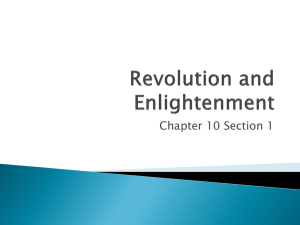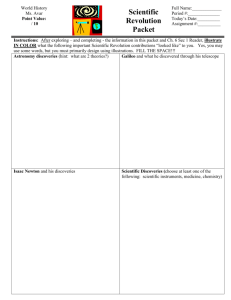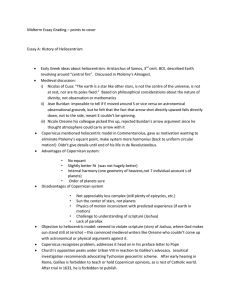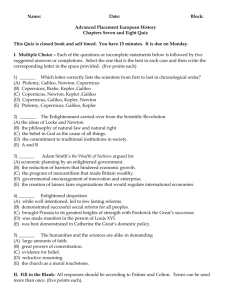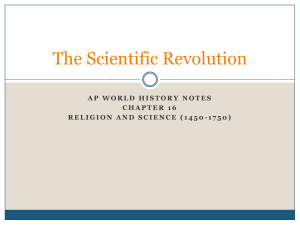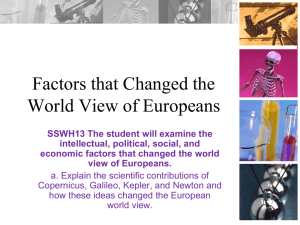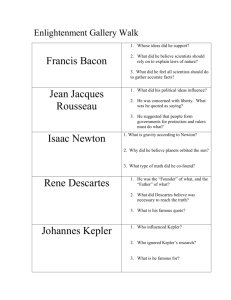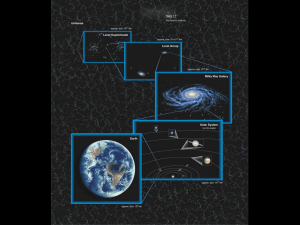Name_______________________________ PHY 1033 HIS 3931 IDH 331 Final exam SOLUTIONS
advertisement
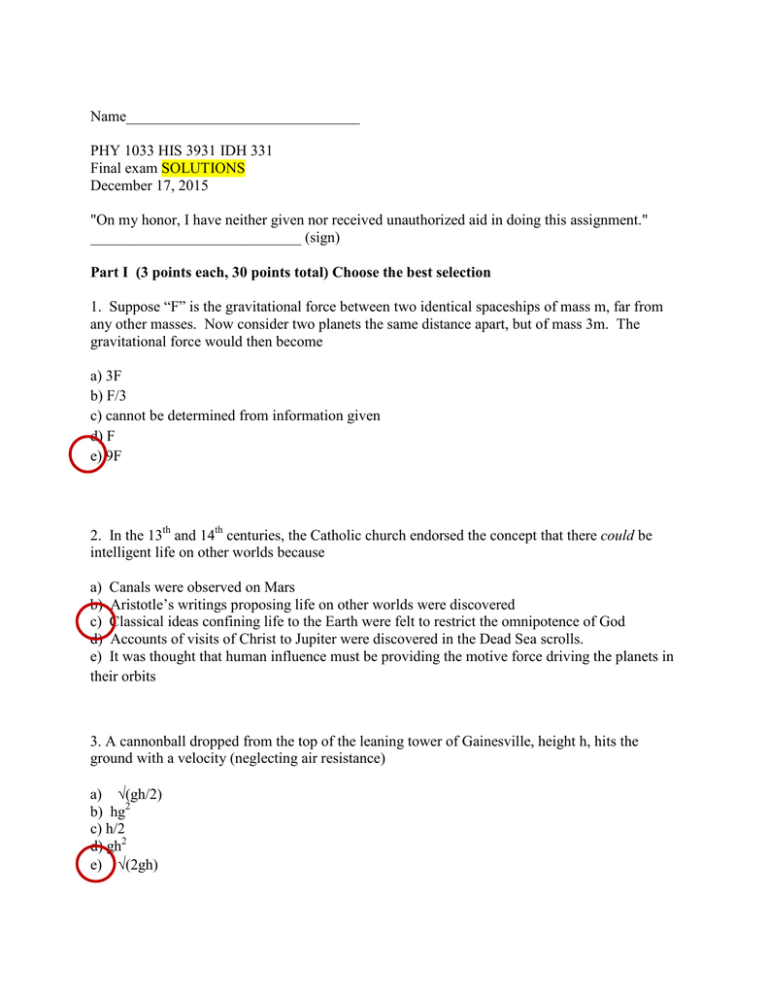
Name_______________________________ PHY 1033 HIS 3931 IDH 331 Final exam SOLUTIONS December 17, 2015 "On my honor, I have neither given nor received unauthorized aid in doing this assignment." ____________________________ (sign) Part I (3 points each, 30 points total) Choose the best selection 1. Suppose “F” is the gravitational force between two identical spaceships of mass m, far from any other masses. Now consider two planets the same distance apart, but of mass 3m. The gravitational force would then become a) 3F b) F/3 c) cannot be determined from information given d) F e) 9F 2. In the 13th and 14th centuries, the Catholic church endorsed the concept that there could be intelligent life on other worlds because a) Canals were observed on Mars b) Aristotle’s writings proposing life on other worlds were discovered c) Classical ideas confining life to the Earth were felt to restrict the omnipotence of God d) Accounts of visits of Christ to Jupiter were discovered in the Dead Sea scrolls. e) It was thought that human influence must be providing the motive force driving the planets in their orbits 3. A cannonball dropped from the top of the leaning tower of Gainesville, height h, hits the ground with a velocity (neglecting air resistance) a) √(gh/2) b) hg2 c) h/2 d) gh2 e) √(2gh) 4. A pond on a hot summer day never freezes by giving up its heat to the air. This is an example of (a) momentum conservation (b) 2nd law of thermodynamics (c) energy conservation (d) 1st law of thermodynamics (e) heat death of the universe 5. Who first noticed that an electric current could deflect a compass needle? a) b) c) d) e) Faraday Maxwell Franklin Oersted Galileo 6. Which of these measurement is Hipparchus known for? a) b) c) d) e) Distance of Earth to moon and sun Weight of the moon Circumference of the Earth None of the above Distance from Marathon to Athens 7. From ancient to medieval times, one of the most persuasive arguments against the motion of the Earth was that if one threw a stone straight up on a moving Earth, it would not fall at the point from which it had been thrown, but somewhere behind it. Using the example of activities on a moving ship, Galileo argued that the stone landed in the same place because a. the stone was pushed sideways by the air carried by the Earth b. a magnetic force kept it moving with the Earth after it had been thrown upwards c. the stone moved with the Earth because it was always attached to an invisible crystalline sphere d. the stone’s tendency is to return to its natural place of rest at the center of the Earth e. the stone has a sideways component of its velocity equal to that of the rotating Earth 8. When Kepler arrived in Prague to become Tycho’s assistant, Tycho assigned him to work on the problem of one planet whose motion fit his model worst. Which planet was it? (Hint: this planet has the largest ellipticity of the known planets at the time). a) b) c) d) e) Venus Jupiter Saturn Mars Mercury 9. Maxwell’s equations had solutions that could be interpreted as light because a) they reduced in a charge-free region to Faraday’s equations for a moving light pulse b) they proved the existence of the ether c) they had exactly the right frequency corresponding to visible light d) he demonstrated that they could exhibit interference phenomena e) the speed of a wave in these solutions was equal to the speed of light measured by astronomical means 10. Bohr’s Planck’s theory of energy quanta a) b) c) d) e) Allowed for a perfect explanation of blackbody radiation Enabled Clausius to prove the 2nd law of thermodynamics Allowed Einstein to explain the photoelectric effect a) and c) a) and b) Part II (2 pts each, total 40 points) Answer the following briefly: 1. Newton’s laws of motion (a) State Newton’s laws of motion. Discuss how they differ from Aristotle’s “laws of motion”, considering both horizontal and vertical motions. 1. An object at rest tends to remain at rest; an object in motion tends to remain in motion -unless acted upon by an external force 2. F=ma Force on an object produces an acceleration of a=F/m 3. For every action there is an equal and opposite reaction (b) If you are just standing still, what forces are acting on you? What are the Newtonian reaction forces to those forces? Gravity (force of Earth on you) is pulling you down. The contact force with the ground is pulling you up. The reaction force to gravity’s pull on you is your pull on the Earth, and the reaction to the ground pushing on you is you pushing back on the ground. 2. A drag racer at Gator Nationals has a mass of 800 kg, and the engines provide a maximum force of 32000 N. Give the peak acceleration of the drag racer in units of g=10 m/s2, the acceleration due to gravity. a = F/m = 32000 N / 800 kg = 40 m/s2 = 4g 3. Centripetal acceleration. A space station is designed as a ring of radius 20 m. a) How fast must it rotate if it is to simulate Earth’s gravity at the edge (speed at the outer rim v)? The acceleration at the rim must match gravity. Centripetal acceleration is v2/r = g = 10 m/s2, so v=√(rg) = √200 m/s = 14.1 m/s b) What is the corresponding angular velocity ω? ω = v/r = 14.1 m/s / 20 m = 0.71 s-1 4. Discuss Galileo’s trial, its origin, context, and outcome. Although Galileo, who clearly believed in the Copernican system, was clever enough to disguise his advocacy by stating heliocentrism as hypothesis rather than fact, his fame disurbs some in the church who worry about the implications of Copernicus for understanding the Bible. Some force the issue by denouncing Galileo publicly. Galileo goes to Rome on his own in 1616 “to see what is permissible to hold.” He is instructed by the pope that he is not to hold or defend the Copernican system, a command he accepts. The trial occurs after publication of Dialogues of the Two Chief Systems of the World, where he effectively ridicules those who hold geocentric views, and insults the pope. He is shown a document, possibly forged, indicating that he had agreed never to consider Copernicus “in any way whatsoever”, which had not in fact been the message of the 1616 meeting. At the end, he is forced, under threat of torture, to publicly renounce, as heresy, espousing (1) that the sun is the center of the universe, and does not move, and (2) the earth is not the center of the universe, and moves with a double motion (rotation about its axis and revolution about the sun). 5. Describe Tycho Brahe’s solar system model, and compare with Copernicus. Draw sketches for both systems. In Tycho’s model, the Earth was stationary at the center, and the moon and the sun rotated around it, but the other planets rotated around the sun (left below). Copernicus place the sun at the center and all planets including Earth rotated around it. Both diagrams are somewhat simplified. 6. Identify and explain briefly Einstein’s 3 discoveries from his Annus Mirabilis 1905. 1) Special relativity: speed of light constant in any frame, space intertwined with time. “Moving clocks run slow, moving meter sticks contract.” 2) Photoelectric effect: shining light on a metal kicks out electrons, but only if the frequency of light is high enough. Einstein says light comes in quanta of energy hf, where h is Planck’s constant and f is the frequency, so if f is too small, the energy of a single photon can’t remove one electron from the metal where it is held in place by a binding energy, so it doesn’t matter if the beam is intense (many photons). 3) Brownian motion. Einstein explains that microscopic particles in a fluid undergo random motion due to collisions with molecules. 7. Interference a) Young showed that light exhibited interference phenomena like water waves. Explain this with a diagram of a Young’s 2-slit experiment. By Huygens’ principle each tiny slit through which light passes emits spherical waveftronts as shown. At the screen, the light from the two slits has traveled a different path length. If the path lengths differ by an integral multiple of the light’s wavelength λ, there is constructive interference, i.e. a maximum of intensity at the screen. If by half-integer λ, destructive interference and a minimum of intensity. Thus at the screen there is an “interference pattern” characteristic of wavelike behavior. b) Explain why modern quantum mechanics suggests that electrons behave like waves in some circumstances, and as discrete particles in some others, using the 2-slit experiment. If you fire electrons at the 2-slit setup rather than light, they will accumulate at the screen in an interference pattern just like the waves. If you try to observe which slit a single electron goes through, you see there is a single particle – but the pattern will disappear! 8. Who said, “I feign no hypotheses”, and in what context? Why was this important for the modern scientific method? Newton, when pressed to give the cause of gravitation between two masses. 9. Name two of Galileo’s great discoveries with his telescope, and explain why they were important. 1) 2) 3) 4) 5) Phases of Venus Moons of Jupiter Many stars that had never been seen before Rough surface of the moon Rings of Saturn 10. Explain why we have seasons, using a diagram. What days mark the beginning of each season in the northern hemisphere? Show where the Earth is on your diagram at the beginning of each season. 11. How did Newton and Descartes differ regarding their notion of what a force was, and how it could act on an object? Descartes thought all forces had to involve physical contact of particles, whereas Newton postulated an “action at a distance” between two objects of mass m in his law of universal gravitation. 12. Describe the Bohr model of the atom, and explain why it was successful. Bohr assumed that the angular momentum of each electron in the atom was quantized, i.e. could only take on certain values, meaning that the radii of the electron orbits were also quantized. When an electron moved between a higher orbit and a lower one, it emitted a photon (particle of light), of an energy hf corresponding to the difference between the energies of the tow orbits. These energies explained the observed spectral frequencies of hydrogen. 13. Explain what 19th century physicists thought the “ether” was. Why did they think it must exist? What proved it didn’t? The ether was supposed to be the medium that supported propagation of light waves. They thought any wave required a medium to exist (light doesn’t). Michelson-Morley experiment measured the same travel times for light parallel to and perpendicular to the ether “wind” sweeping over the Earth due to its motion around the sun, and found them to be equal, therefore there was no ether. 14. Copernicus was proudest of having found a solar system model that “eliminated the equant” Explain the definition of the equant, its history, and what Copernicus did to “eliminate” it. In Ptolemy’s model, the Earth was moved off center by a small amount, and the sun rotated with constant angular speed about a point (equant) on the other side of geometric center. Ptolemy needed to introduce it because observations were getting accurate enough to show that the sun’s motion around the Earth (or other way around!) wasn’t a circle moving at constant speed, and even adding epicycles wasn’t enough to reproduce the observations. Copernicus “eliminated” the equant by having the planets circle the sun (still using epicycles though). 15. The 20th century conclusion that the universe was expanding depended on knowing the distance to faraway stars and galaxies. Describe one method of measuring such distances, and identify who discovered it. Henrietta Leavitt at Harvard in 1908 studied Cepheid variables – stars that oscillate in brightness. She found an intrinsic relation between brightness and period. Now it was possible to compare different stars with the same period; if they were dimmer, they were further away, since brightness decreases as 1/r^2 as a function of the distance of the star. Hubble used Leavitt’s measures of short astronomical distances to invent his own scale for galaxies, by measuring their redshift (Doppler shift of spectral lines). Part III. (30 pts) Essay. Choose one of A, B or C (Do not do more than one). A. Describe the development of the modern scientific method, starting from the ancient Greeks until the modern era until the modern era, with specific examples from important scientists. Refer to at least three of the following Aristotle Galileo Descartes Huygens Newton Michelson B. From the following list of major figures in the development of our understanding of the motion of earthly bodies (not the Earth!), identify the contributions of any four of them and explain how each arrived at his results. When appropriate, identify aspects of the individual’s ideas which were incorrect as viewed from the modern perspective. Aristotle Buridan Galileo Newton Einstein C. Using ideas from the Bronowski film “Knowledge and Certainty”, discuss the notion of certainty, tolerance and determinism, first contrasting the ideas of Laplace with those of the theorists who developed the kinetic theory of gasses, and with those of Heisenberg and modern quantum theory. Describe in your discussion how the role of the observer has evolved. How does Bronowski connect the act of observation or measurement with the notion of scientific tolerance or openness?
